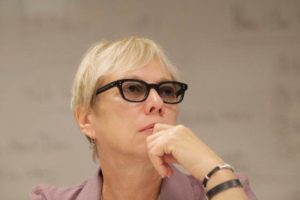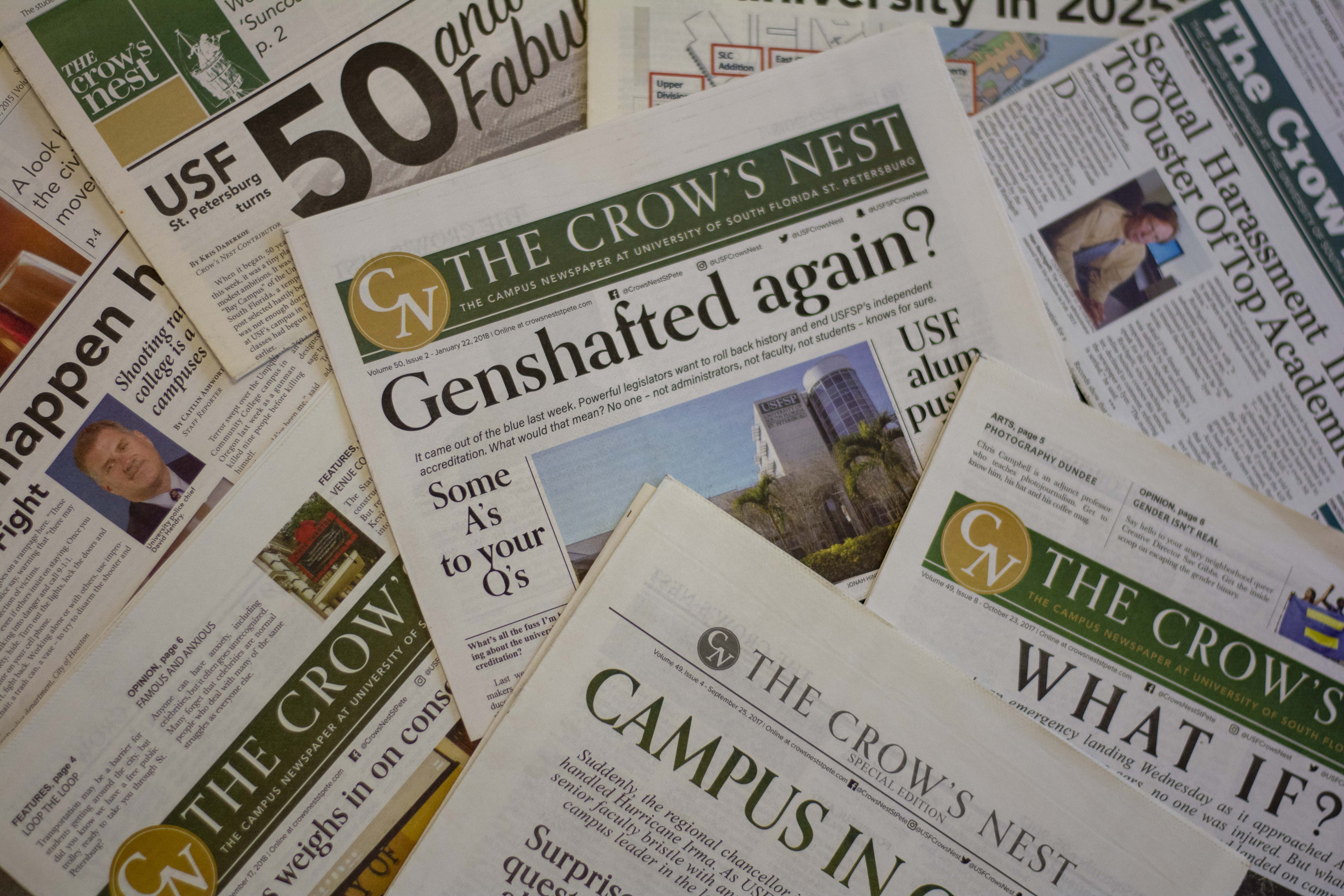The consolidation subcommittee for student involvement has put together recommendations for the unification of student organizations from student government to student publications.
Journalism Faculty: ‘It would undermine student success.’
This is a letter that the faculty of the Department of Journalism and Digital Communication in St. Petersburg is sending to administrators on both campuses.

The Department of Journalism and Digital Communication at USF St. Petersburg strongly opposes the merging of The Crow’s Nest with The Oracle.
Merging the publications would undermine student success and the promise of each campus to retain its unique identity – both of which have been emphasized time and time again as the concept of consolidation has crystallized.
The Crow’s Nest is an independent campus newspaper primarily serving the interests of USF St. Petersburg students. It has been a vital part of the fabric of campus life and an essential element in the department’s instructional mission.
The paper serves as a standalone learning lab for students who rely on The Crow’s Nest as a venue to report and publish. They receive professional recognition for their stories and gain valuable experience, while adding content to the portfolios they are required to produce before graduation.
In many instances, Crow’s Nest writers, editors and designers have gone on to internships that have led to paid positions at the Tampa Bay Times, Bradenton Herald, Creative Loafing and numerous other local and regional media outlets.
Maintaining The Crow’s Nest as a separate product will ensure editors have final say on what makes it into the paper and what goes online. It will keep coverage local, focused on our distinct campus.
Collaboration between the papers is, perhaps, a good idea. But that can be explored in ways other than a merger, which presents far more risk than reward.
_________________________________________________________________________
Caitlin Ashworth: ‘Campuses could not be more different.’
By Caitlin Ashworth

As a former editor and reporter for The Crow’s Nest, I fear that merging the newspaper with The Oracle in Tampa could lead to a drop in involvement from St. Petersburg students as well as a decline in the amount and quality of local content.
I attended both campuses. They couldn’t be more different.
USF Tampa has nearly 44,000 students, approximately nine times more than the 4,800 students in St. Petersburg. The Tampa campus covers 1,562 acres, which makes it over 30 times the size of St. Petersburg’s 52-acre campus.
The St. Petersburg campus is bordered by a harbor, an airport and downtown, leaving little room to grow, either horizontally or vertically. There’s limited dormitory space and/or affordable housing close to campus.
The harbor is burdened by trash build-up. Students have worked to keep it clean by organizing the installation of trash collecting devices.
Those are some of the concerns for the St. Petersburg campus that just aren’t relevant to Tampa students.
Not only are the campuses different, but they are also 35 miles apart with Tampa Bay in between.
The distance would impact the involvement of St. Petersburg students. Some students do not have a car. Some have a tight work schedule. Some have children.
While reporters and photographers can send in their work remotely, the top editors would need to travel to both campuses.
The subcommittee recommendations don’t address a key question: Who would make the final decisions on what stories and photos go on the front page?
If the editor-in-chief is based in Tampa and is not well versed on the ins and outs of the St. Petersburg campus, St. Petersburg readers might be shortchanged. The same thing could happen to Tampa readers if the editor-in-chief is based in St. Petersburg.
To embrace student journalism, the university system should promote the addition of multiple student publications, sparking creativity and competition, rather than combine the two papers for efficiency purposes.
Or better yet, you should purchase an advertisement in The Crow’s Nest, and maybe one day it can become a truly independent student newspaper.
Caitlin Ashworth, who was news editor and managing editor of The Crow’s Nest in 2015-2016, interned at the Sarasota Herald-Tribune and Richmond (Va.) Times-Dispatch before becoming a reporter at the Daily Hampshire Gazette in Northampton, Massachusetts. She now teaches English to elementary school students in Surat Thani, Thailand.
_________________________________________________________________________
Michael Moore: ‘Don’t mess with history, tradition’
By Michael Moore Jr.

Another year at USF St. Petersburg means another year of university officials mucking around with the campus newspaper.
As a former editor-in-chief, news editor and reporter for The Crow’s Nest, I’ve seen some dumb, puzzling and sometimes just plain awful ideas – especially when it comes to an independent student press.
Consolidating the campus newspaper with The Oracle at USF Tampa might be the worst idea yet.
A subcommittee led by Danielle McDonald, an assistant vice president and dean of students on the Tampa campus, and Dwayne Isaacs, the director of student life and engagement at USF St. Petersburg, has recommended combining the papers, with a section for each campus.
Each section could retain its current name and its own editors, according to the recommendations, but the joint operation’s advertising and “paper completion” (whatever that means) would be overseen by one university office.
Combining The Crow’s Nest and The Oracle doesn’t make sense, unless the goal is pinching pennies and cutting corners. It would only serve to cheapen the experience of journalism students at both campuses and detract from the quality of reporting.
One university office overseeing anything to do with a student-run publication serving two campuses sounds unwieldy. What happens to values such as transparency and independence in such a clumsy infrastructure?
For a university that has shown little enthusiasm for an independent student press in the past, having one newspaper to control instead of two seems awfully convenient.
So, I’m just going to come out and say it: I don’t trust them. I don’t trust the intentions of the recommendations, I don’t trust the intentions of the subcommittee, and I absolutely, unequivocally do not trust the intentions of this university.
Why would I? They have done little to earn trust and a lot to make me suspicious of their motivation.
The fact that this is even being discussed is disturbing. That The Crow’s Nest was not even consulted is disgusting. The university trying to pull the carpet out from under the newspaper, however, is hardly surprising.
We have seen it before.
Last year there were rumors of budget cuts (which, at times, seemed more like thinly veiled threats) and a proposal to put the paper under the control of the journalism department, where faculty would inevitably feel pressure from the administration.
The journalism faculty, which believed the paper should remain in the hands of student editors, brought in the former executive director of the Student Law Press Center for a presentation, and the proposal died.
The year before brought actual budget cuts. Around 15 percent of our budget was slashed by Student Government around the time SG leaders and a university staff member tried to convince us that some stories were off limits.
So, when I heard what the university was up to this year, I thought to myself: new year, same story.
Last year The Crow’s Nest, along with hundreds of other campus newspapers around the nation, published #SaveStudentNewsrooms editorials in conjunction with a movement started by the Independent Florida Alligator at the University of Florida.
In our editorial, we wrote:
“We become journalists knowing that it’s a thankless job, but that doesn’t stop us from giving it our all and trying to bring you the best news possible. It doesn’t stop us from dropping everything at a moment’s notice, it doesn’t stop us from accepting the low pay and terrible hours, and it will never stop us in the quest to ‘seek truth and report it.’
“We’re not the Tampa Bay Times, but we’re still a newsroom. So don’t stop us from being one.”
Between The Crow’s Nest and The Oracle there is more than a hundred years’ worth of history. It predates the separate accreditation of USF St. Petersburg of 2006 and it should survive the consolidation coming in 2020.
In this instance, I would amend the words of that editorial to read: We’re still the campus newspaper of USF St. Petersburg. Don’t stop us from being that.
Michael Moore Jr., a senior in journalism and digital communications, was Crow’s Nest editor-in-chief last year. He has interned at the Bradenton Herald and Sarasota Herald-Tribune.
_________________________________________________________________________
Crow’s Nest Editors: ‘It sounds like a recipe for chaos’
By Crow’s Nest Staff

The following was emailed to Dwayne Isaacs, director of student life and engagement in St. Petersburg; Danielle McDonald, assistant vice president and dean of students on the Tampa campus; Martin Tadlock, regional chancellor of USF St. Petersburg; and Patricia Helton, regional vice chancellor for student affairs.
Thank you for the opportunity to elaborate on our emphatic opposition to the proposed merger of The Crow’s Nest and The Oracle.
Nowhere in the law mandating the consolidation of the three USF campuses is there mention of consolidating the newspapers.
In fact, legislators stressed that they wanted to preserve programs and traditions that give each campus its distinctive identity.
The Crow’s Nest and Oracle have been part of the fabric of their campuses for half a century. As our campuses have grown and prospered, the papers have informed, entertained and – yes – provoked students, faculty and staff. They have also helped train countless students for careers in journalism, communications, business, the law and other fields.
Even when St. Petersburg was under the control of Tampa, the papers were separate. It only made sense. Two campuses separated by 35 miles and a long bridge have different constituents, different priorities and different needs.
Our campuses are united now in the goal of preeminence, but that changes little about the readership and missions of the two newspapers.
Philosophy aside, the practical challenges of a merger would be daunting.
You recommend one paper, with a new name, that would be wrapped around a St. Pete section and a Tampa section. Each section would have its own editor.
But who would decide what content to place on the front page? Who would design the pages of this lumpy product? Would the current amount of content be cut? And wouldn’t it be wasteful to deliver a lot of Tampa-based content to a St. Pete readership that has no interest in it, and vice versa?
To us, that sounds like a recipe for chaos.
Students come to the St. Petersburg to study in our nationally accredited Department of Journalism and Digital Communication and gain valuable practical experience at The Crow’s Nest.
The subcommittee’s recommendations could weaken the newspaper, harm recruitment and undermine a goal we all embrace – student success.
We are also reluctant to endorse an all-digital product, at least for now. A Pew Research Center study in 2016 found that half of newspaper consumers read papers only in their printed form. Going to a digital-only format here might limit employment opportunities for our graduates.
Even more important, a printed paper sends a physical, tangible signal to our campus that someone is watching out for the best interests of students.
Although we resolutely oppose the recommendations of the subcommittee, there has been one positive in all this.
Editors at both papers agree that we should collaborate more. The Crow’s Nest could publish some Oracle stories on the football team, for example, and a St. Pete sailing feature might appeal to Tampa readers. Both papers publish features, profiles, reviews and commentary that might resonate on both campuses.
Moreover, we stand ready to help the students in Sarasota-Manatee if they would like to establish a newspaper there. Our staff already feels a kinship to those two counties. We have had interns at the Sarasota Herald-Tribune for the last four years and at the Bradenton Herald for the last two.
Please let us know if you want to know more. Thanks for hearing us out.



